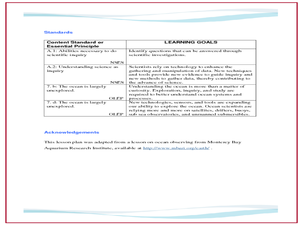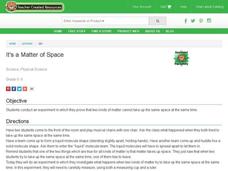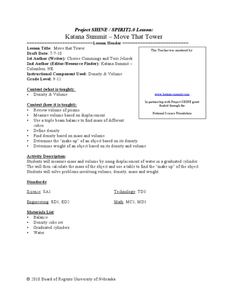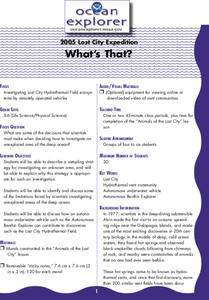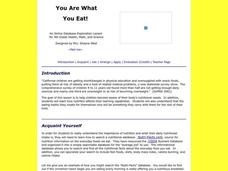Curated OER
Ocean Observations
Students examine a coastal ocean. In this physical science/earth science lesson, students generate a list of questions about how researchers study the ocean. In addition, students investigate, through research on the computer, to answer...
Curated OER
Boning Up on Fossil Features
Students investigate a specific dinosaur; produce a poster relating what is known or speculated about where and how the dinosaur lived to the physical features of the dinosaur.
Curated OER
Concrete Research
Students explore concrete. In this physical science and computer research lesson plan, students work in groups to answer specific questions about concrete. Each group of students completes a different worksheet with a specific...
Curated OER
It's a Matter of Space
Students explore matter. In this physical science lesson, students role play the 3 states of matter forming "liquid" molecules and "solid" molecules with teammates. Students perform an experiment in which the result illustrates that two...
Curated OER
Move that Tower
Young scholars investigate ways to find the density of irregular shaped objects. In this physics lesson plan, students calculate density using its mass and volume. They explain why some objects float or sink in water.
Curated OER
Simply Circuitry and Series Circuit
Young scholars investigate a series circuit. In this physical science activity, students use a battery, switch, and light bulbs to build an electrical circuit. Young scholars identify the standard symbols being used in electric circuitry.
Curated OER
Physics Quiz
For this physics worksheet, students complete short answer questions about physics concepts such as electricity, space, light, and more. Students complete 20 short answer questions.
Curated OER
Experimenting with Sound
Students explore physical science by completing a worksheet. In this sound perception activity, students collaborate in small groups to research sound properties on the Internet and in libraries. Students conduct a listening experiment...
Curated OER
Matter and Energy
Learners investigate the effects of air pressure on humans by utilizing the Internet. In this physical science lesson, students research the Internet to discover altitude sickness and air pressure. Learners prepare against...
Curated OER
Physics of Space Flight
In this space flight instructional activity, learners will review physics terms relating to space which includes measuring the distance of space objects, how rockets work, and electromagnetic waves. This instructional activity has 10...
Curated OER
Energy Efficiency: It really IS important!
Learners compare the energy needed to produce new products versus recycling. In this physics lesson plan, students brainstorm ways to save energy. They create a presentation about the correlation between conserving energy and energy costs.
Curated OER
Invisible Rays
Students explore physical science by completing a lab assignment. In this sunlight instructional activity, students define a list of scientific vocabulary terms and complete fill in the blank questions. Students conduct a photographic...
Curated OER
Is That Icebox Green?
Seventh graders create a timeline of the development of electrical appliances. In this physics lesson, 7th graders explore energy consumption over the past 90 years. They create a poster about their chosen electrical device detailing its...
Curated OER
What is ergonomics and why is it important?
Students come up with ideas to help friendly, superintelligent space aliens adapt to this environment.
Curated OER
What Is the Matter with Water?
Second graders observe matter in all 3 states : liquid, solid and gas, in an ice cream soda. In teams, they are given ice and teams compete to be the first to melt their ice. Winner gets the ice cream soda. They draw examples of 3 states...
Curated OER
What is in a Name?
Students examine taxonomy and the use of dichotomous keys through two activities. They use a dichotomous key and create one of their own as well as create new scientific Family names for penguins using same word roots used by taxonomists.
Curated OER
What Is That Bubblin¿¿¿ In My Back Yard?
Students create a map plotting local sites the Environmental Protection Agency has on its EPA Regulated Sites list. They discuss the need for citizens to, at a minimum, be aware of potential pollution hazards in their community.
Curated OER
What Does the Sun Give Us?
Pupils study the sun and how solar energy works. To learn about renewable energy, they complete a lab activity using a pizza box as a solar heater. Quite clever!
Curated OER
What's That?
Meant to be a simulation of a deep-sea exploration, this requires that another instructional activity be completed first. In that instructional activity, titled "Animals of the Lost City," marine biology buffs construct murals of benthic...
Curated OER
You Are What You Eat!
Fourth graders discover the nutritional needs of their bodies. Using a database, they research how nutrition affects their learning capabilities. They take the food they eat on a daily basis and discover its nutritional value. They...
Curated OER
What is a Solution?
In this solutions activity, students read about how people first learned to use metals and to combine metals to form alloys. Students write an essay telling the story of how ancient people first learned to cause physical changes in metal.
Curated OER
Strawkets and Weight
Students investigate the effect that weight has on rocket flight. They construct a variety of straw-launched rockets that have different weights, observe what happens when the weight of a rocket is altered by reducing its physical size...
Curated OER
Radiation and You
Internet research on nuclear radiation is conducted by young physicists. They discover how our understanding of radiation developed, define vocabulary terms, and explore how ozone protects us from the sun's harmful radiation. Several...
Curated OER
Pumpkins
Observe the differences between the inside and outside of a pumpkin. Learners discuss what pumpkins are used for and then view a pumpkin. Next, they view the inside of the pumpkin and draw the differences they see.
